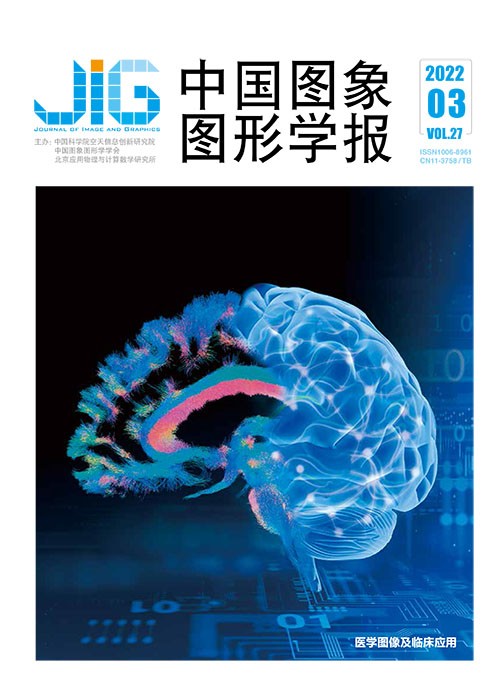
基于图像的介入器械前端变形建模与受力估计
摘 要
目的 血管介入手术中介入器械与血管壁之间的接触力对手术安全有着重要意义,然而目前缺乏直接测量器械前端与血管壁接触力的传感器和有效手段。为解决这一难题,本文提出了一种通过图像观察器械前端变形程度从而估计器械与血管壁接触力的方法。方法 通过模拟血管介入手术过程来获取介入器械导丝的变形量和与之相对应的力,从而对介入器械前端接触力与变形量关系进行建模。将介入器械前的端接触力分为垂直于接触面方向的力和沿着接触面方向的力并分别加以处理;使用介入器械前端变形段的最大曲率变化量描述器械变形量,通过图像观察导丝变形来计算导丝的最大曲率。为求解最大曲率,使用器械上3个点构成的三角形并求其外接圆曲率来表示这3点所在段的曲率,在介入器械前端进行依次遍历求取最大值以获得最大曲率。通过实验分析验证介入器械受力与最大曲率之间的关系。结果 实验表明介入器械前端的接触力与器械前端最大曲率变化率之间存在着映射关系,且这种关系能用函数表达式准确地表达出来,通过函数式来预测受力的平均误差在10%以内。结论 研究表明,通过图像分析导丝前端的变形量、估计导丝前端接触力,进而判断血管手术过程中介入器械与血管壁的接触状态的方法是可行的,所计算的导丝前端受力能为手术过程提供参考信息。
关键词
Image-based deformation modeling and force estimation of the front end of vascular interventional surgical apparatus
Ren Longfei1, Meng Cai1,2, Liu Bo1,2, Bai Xiangzhi1,2, Zhou Fugen1,2(1.School of Astronautics, Beihang University, Beijing 102206, China;2.Biomedical Engineering Innovation Center, Beihang University, Beijing 100083, China) Abstract
Objective At present, the prevalence of cardiovascular disease continues to increase in China. Approximately 290 million people in China suffer from cardiovascular and cerebrovascular diseases. In 2016, the mortality rate of cardiovascular disease was the highest in China. Cardiovascular disease has caused a serious burden on the society; thus, the prevention and treatment of cardiovascular disease are urgent. Vascular interventional surgery is one of the main methods for the treatment of cardiovascular diseases, which has the advantages of less blood loss, less trauma, less complications, and rapid postoperative recovery. In the process of vascular interventional surgery, the contact force between the front end of the interventional instrument and the vascular wall is greatly important to the safety of the operation. If the contact force is extremely large, then the vascular wall becomes scratched and punctured or the plaque is moved, thereby leading to the failure of the operation and may cause danger to the lives of patients. Therefore, measuring the contact force of the front end of interventional instruments is a difficult problem in the process of vascular interventional surgery. To solve this problem, this paper creatively proposes a method to estimate the contact force between the instrument and the vascular wall by observing the deformation of the front end of the instrument. Method To solve this problem, different from the commonly used force feedback method, a method to predict the contact force of the front end of interventional instrument based on image acquisition is proposed. An experimental environment was built to simulate the process of vascular interventional surgery, a force sensor was used to measure the contact force of the front end of the interventional device, and a camera was used to obtain the image containing the deformation of the interventional device. For the image with deformed guide wire, multiframe background averaging method is used to model the background. Canny operator is used to detect the edge of the original image and the background. The edge in the background is removed from the edge of the original image, and then morphological filtering method is used to process the detected edge image to obtain the contour of the interventional device. The deformation of the front end of the interventional device is calculated by the contour of the interventional device. Here, the contact force and deformation of the front end of the interventional device are modeled. The contact force of the front end of the interventional device is divided into the force perpendicular to the contact surface and the force along the contact surface. A method is proposed to describe the deformation of the instrument by using the maximum curvature of the deformation section at the front end of the guide wire. We use the triangle composed of three points on the instrument to solve the maximum curvature, and its circumscribed circle curvature is calculated to represent the curvature of the segment, where the three points are located. Then, and it is traversed at the front end of the interventional instrument to obtain the maximum value, which is the maximum curvature. Subsequently, the relationship between the force and the maximum curvature of the interventional device is obtained by analyzing the experimental data. Result The results show some mappings between the front-end contact force and the maximum curvature of the interventional device. This relationship can be accurately expressed in functional expressions with an average error of less than 10% in predicting forces. At the same time, the force perpendicular to the contact surface is much greater than the force along the contact surface. The force perpendicular to the contact surface can be used to approximately replace the contact force between the front end of the interventional device and the vascular wall. In a certain range, the contact force of the front end of the interventional device increases with the increase in the maximum curvature. Beyond this range, the contact force of the front end of the interventional device reaches the maximum and does not continue to increase with the increase in the maximum curvature. Conclusion Therefore, we can estimate the contact force of the front end of the guide wire by obtaining the maximum curvature of the front end of the guide wire, and then judge the contact state between the interventional device and the vascular wall during vascular surgery. Through this method, adding sensors and other devices on the interventional device is unnecessary, and the contact force of the front end of the interventional device can be obtained to reduce the risk of vascular wall being scratched or punctured by the front end of the interventional device. In addition, the difficulty of operation is reduced, and the operation power is improved.
Keywords
vascular interventional surgery contact force of interventional device deformation of interventional device guide wire image maximum curvature
|



 中国图象图形学报 │ 京ICP备05080539号-4 │ 本系统由
中国图象图形学报 │ 京ICP备05080539号-4 │ 本系统由